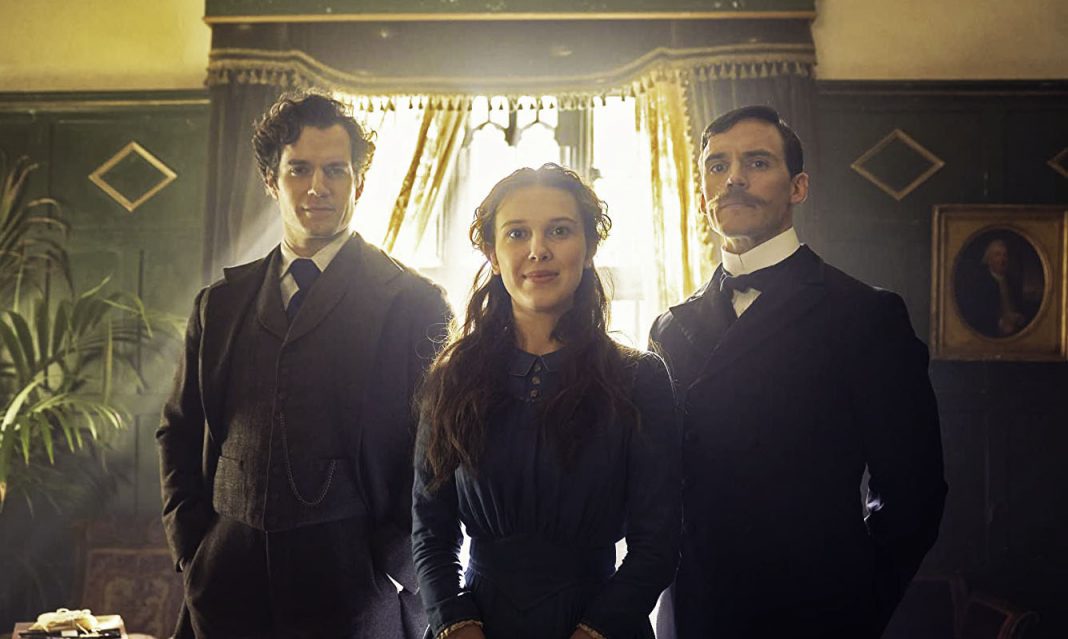Sherlock Holmes is a familiar name around the world. But what about Enola? If you haven’t heard the name before, you will soon with the release of Netflix’s newest romp, Enola Holmes.
The film is based on the YA novel series The Enola Holmes Mysteries, written by Nancy Springer, and follows the story of the first book: The Case of the Missing Marquess. While Enola doesn’t exist in Sir Arthur Conan Doyle’s original Sherlock Holmes novels, she does in Springer’s adapted series as the third Holmes sibling—the younger sister of Sherlock and Mycroft.
Enola Holmes is played by rising actress Millie Bobby Brown, famous for her role as Eleven in Stranger Things. Enola is a young girl who lives with her mother Eudoria (Helena Bonham Carter) in the sprawling Ferndell Hall. Her older brothers left long ago; leaving the mansion all to them. From a young age, Enola trained mentally and physically, neglecting the era’s typical feminine expectations. Embroidery, corsets, and manners were replaced with science, reading, and martial arts. These skills are challenged when her mother goes missing on the morning of her 16th birthday.
Using the clues left to her, Enola goes off to find her mother. However, she isn’t the only one looking. Sherlock (Henry Cavill) and Mycroft (Sam Claflin) return home with the same goal, though the latter brother has other plans in mind.
As Enola searches for her mother, she meets the Viscount Lord Tewkesbury (Louis Partridge), the Marquess of Basilwether, who also defies common Victorian expectations. They’re both on the run, but for different reasons. With so many obstacles and unanswered questions ahead, Enola Holmes brings back the familiar excitement of mystery, only this time with a new detective.
One of the most exciting aspects of this film is that we’re in it. From time to time, Enola breaks the fourth wall, speaking and looking and winking at us. It doesn’t happen too often to be overbearing, but just enough for a delicate balance between showing and telling the story. We get the explanation of the problem, a chance to investigate some situations ourselves, then witness Enola’s solution.
Moreover, the cinematography sets the tone for the genre very well, immersing you in the feeling that this is one giant puzzle to solve. During thrilling moments, the shot cuts quicken, and the music intensifies, moving the scenes along and building suspense. Periodic flashbacks, illustrations, and old-timey texts only add to the fast-paced amusement and adventure.
Meanwhile, the well-chosen cast was a cherry on top of this delectable mystery. Milly Bobby Brown is enthusiastic and charismatic, endearing Enola with a believable eccentricity that steals every scene. Henry Cavill’s Sherlock differs from the aloof detective of yore but is nonetheless intriguing to watch. Sam Claflin was a pleasant surprise, expressing all of Mycroft’s contempt with his grimacing moustache. And in my eyes, Helena Bonham Carter can do no wrong. Even as she’s missing for much of the story, her implied presence lingers with us throughout the film.
Ultimately, what makes this movie so memorable is its message.
Even in its chaotic mysteries, Enola Holmes explores the fight and struggle for women’s rights and freedoms, getting personal with privilege and the lengths people will go to uphold a patriarchal society. We see Enola’s desire to live freely for who she is, not the “lady” others want her to be. But that doesn’t mean she can’t wear dresses while saving the day. And that’s the key—choice. To choose to wear corsets. To choose to learn sports. To vote. To break free of expectations placed upon you, which applies not only to Enola, but other characters like Tewkesbury.
Seeing these characters shatter their limitations ignites a spark in those who the world continually fails to consider. As the film concludes, “the future is up to us.”



